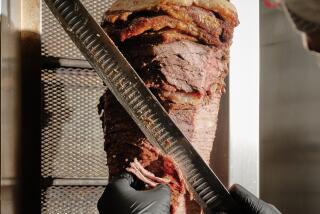Crouching Tiger, Hidden Tandoori Nan
- Share via
Have you ever seen Uighur food? You have, very briefly, if you saw “Crouching Tiger, Hidden Dragon,” the Chinese sword-fighting epic (just released on video this month).
When the roguish bandit Lo rescues the feisty young swordfighter Jen in the deserts of Xinjiang, he takes her back to a sort of pirate cave and feeds her roast qawarchi fowl and a loaf of bread that looks like a cross between a single-serve pizza with a hugely raised edge and a round bun that’s been flattened in the middle.
Lo may dress like a Tibetan and his bandit gang may look like Kazakh nomads, but the song he sings her about seeing a pretty girl seems to be in Uighur, the language of the farming people of the oases of Xinjiang. And that round bread is a local version of tandoori naan made by the Uighurs (who pronounce the first syllable of their name “oo-ee,” by the way, though the Chinese tend to pronounce it “way”).
So it’s totally a Middle Eastern sort of bread, despite China’s long political control of Xinjiang. The Uighurs, who are Muslims, have adopted some Chinese foods, such as the steamed bun jingmoma , but they still make samosas and halva and many other familiar Middle Eastern dishes. Cooking Persian in the shadow of China is a long tradition there. A thousand years ago, earlier Turkish-speaking inhabitants of Xinjiang were willing to adopt a lot of things like household furnishings from the Chinese, but they still used a Persian word for noodle.


